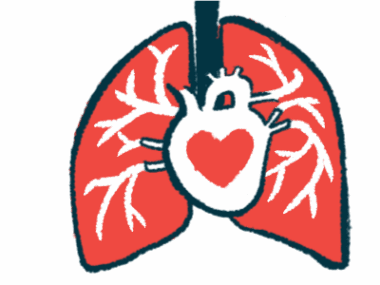IPF Progression Linked to Increased Type VI Collagen Formation in Study
Written by |

Idiopathic pulmonary fibrosis (IPF) patients with increased formation of type VI collagen — a major extracellular matrix (ECM) molecule involved in wound healing and scarring — are at higher risk of having progressive disease, a real-world study shows.
Also, type VI collagen breakdown tended to increase in patients with progressive disease and normalize in those receiving anti-scarring therapies.
These findings add to previous studies showing an association between increased formation and degradation of other types of collagen and progressive IPF, suggesting that measuring markers of these processes may reflect and/or predict disease progression.
The study, “Longitudinal serological assessment of type VI collagen turnover is related to progression in a real-world cohort of idiopathic pulmonary fibrosis,” was published in the journal BMC Pulmonary Medicine.
ECM is a network of molecules and proteins, such as collagen, that surrounds and supports cells, but, when overly produced, can cause tissue scarring or fibrosis. ECM remodeling, the process by which ECM molecules are produced and broken down, is a central mechanism in IPF progression.
A previous study conducted by a team of researchers in Denmark showed that the turnover of type I and III collagen in newly diagnosed IPF patients predicted disease progression within one year. Turnover is a balance between the production and degradation of a given molecule.
Now, the same team of researchers looked at the turnover of type VI collagen, whose remodeling has been suggested to be associated with IPF progression.
They analyzed blood levels of PRO-C6, a marker of type VI collagen formation, and C6M, a marker of type VI collagen degradation, in 178 people newly diagnosed with IPF in a real-world setting.
Patients were the first participants of an ongoing five-year prospective clinical trial, called Pulmonary Fibrosis Biomarker (PFBIO; NCT02755441), with blood samples from study’s start (baseline), six-, and 12-month visits.
PFBIO is following newly diagnosed IPF patients at two large centers in Denmark to identify relevant blood biomarkers of disease progression.
At enrollment, patients’ mean age was 73.8 years, and 76.4% of them were men. During follow-up, most (79.7%) patients initiated standard IPF treatment — either Genentech’s Esbriet (pirfenidone) or Boehringer Ingelheim’s Ofev (nintedanib).
Those not receiving standard anti-scarring therapy were older and walked a shorter distance in six minutes (a measure of exercise capacity).
One year after diagnosis, nearly half (47.2%) of patients were classified as having progressive disease, based on declines in standard lung function tests conducted over that period. There was no difference in the number of patients with progressive disease between the different treatment groups.
Results showed that PRO-C6 and C6M levels were both about 12% higher — reflecting higher type VI collagen turnover — among patients with progressive disease relative to those with stable disease at all three time points. However, these differences only reached statistical significance for PRO-C6.
In addition, across all time points, untreated patients had significantly higher blood levels of PRO-C6 (by 13%) and C6M (by 21%) than those who initiated treatment, reflecting higher type VI collagen turnover.
C6M increased from baseline to one year in patients without treatment, but it remained unchanged in treated patients. Changes in PRO-C6 levels over time were not statistically different between groups.
Subgroup analyses showed that C6M levels were significantly higher (by an average of 34%) at all time points in progressive IPF patients who did not receive treatment, while PRO-C6 levels were significantly higher (by a mean of 16%) across all time points among untreated patients with stable disease.
The reason for this difference between groups with progressive and stable disease is “presently unknown and may represent intrinsic differences between the two groups that are not explained by our data or merely due to chance,” the team wrote, adding that the small number of untreated patients may also have limited these analyses.
Moreover, there were no differences in biomarker levels between patients receiving Esbriet or Ofev, and these levels “seemed to be stable over 12 months in both groups of patients,” the researchers wrote.
These findings highlighted that increased type VI collagen formation and to some extent breakdown were “related to progressive disease in patients with IPF in a real-world cohort,” and as such, markers of these processes “might be potential biomarkers for disease progression in IPF,” the researchers wrote.
“Furthermore, this study indicates that antifibrotic treatment might normalize type VI collagen degradation,” they wrote.
Further studies with larger numbers of patients and with longer disease durations are needed to confirm these findings, which “could provide valuable information for clinicians to identify patients at high risk of disease progression,” the team wrote.







